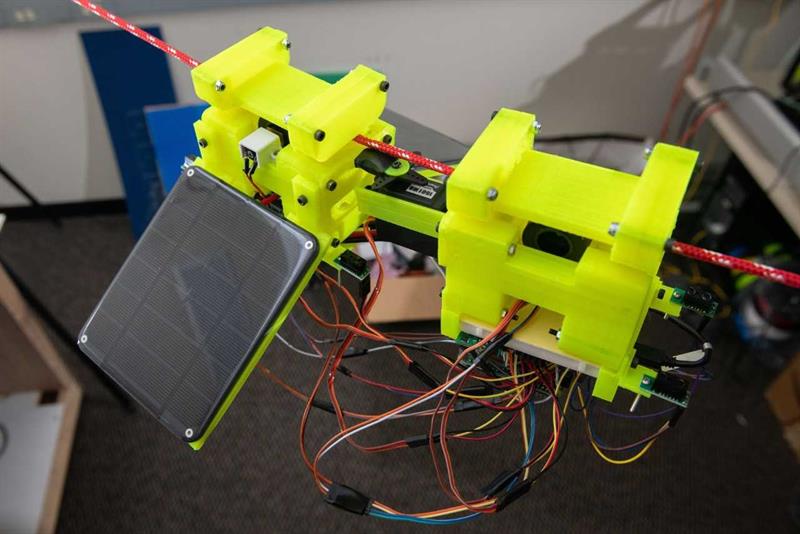Powered by a pair of photovoltaic panels and designed to linger in the forest canopy continuously for months, the SlothBot moves only when it must to measure environmental changes – such as weather and chemical factors in the environment – that can be observed only with a long-term presence. The proof-of-concept hyper-efficient robot, was unveiled at the International Conference on Robotics and Automation (ICRA) in Montreal last month.
“In robotics, it seems we are always pushing for faster, more agile and more extreme robots,” said Magnus Egerstedt, the Steve W. Chaddick School Chair of the School of Electrical and Computer Engineering at the Georgia Institute of Technology and principal investigator for Slothbot. “But there are many applications where there is no need to be fast. You just have to be out there persistently over long periods of time, observing what’s going on.”
Based on what Egerstedt called the “theory of slowness,” Graduate Research Assistant Gennaro Notomista designed SlothBot together with his colleague, Yousef Emam, using 3D-printed parts for the gearing and wire-switching mechanisms needed to crawl through a network of wires in the trees. The greatest challenge for a wire-crawling robot is switching from one cable to another without falling, Notomista said.
“The challenge is smoothly holding onto one wire while grabbing another,” he said. “It’s tricky and you have to do it right to provide a fail-safe transition. Making sure the switches work well over long periods of time is really the biggest challenge.”
Mechanically, SlothBot consists of two bodies connected by an actuated hinge. Each body houses a driving motor connected to a rim on which a tire is mounted. The use of wheels for locomotion is simple, energy efficient and safer than other types of wire-based locomotion, the researchers say.
SlothBot has so far operated in a network of cables on the Georgia Tech campus. Next, a new 3D-printed shell – that makes the robot look more like a sloth – will protect the motors, gears, actuators, cameras, computer and other components from the rain and wind. That will set the stage for longer-term studies in the tree canopy at the Atlanta Botanical Garden, where Egerstedt hopes visitors will see a SlothBot monitoring conditions as early as this fall.

The name SlothBot is not a coincidence.
“The life of a sloth is pretty slow-moving and there’s not a lot of excitement on a day-to-day level,” said Jonathan Pauli, an associate professor in the Department of Forest & Wildlife Ecology at the University of Wisconsin-Madison, who has consulted with the Georgia Tech team on the project. “The nice thing about a very slow life history is that you don’t really need a lot of energy input. You can have a long duration and persistence in a limited area with very little energy inputs over a long period of time.”
That’s exactly what the researchers expect from SlothBot, whose development has been funded by the U.S. Office of Naval Research. The researchers also hope to test SlothBot in a cacao plantation in Costa Rica that is already home to real sloths. “The cables used to move cacao have become a sloth superhighway because the animals find them useful to move around,” Egerstedt said. “If all goes well, we will deploy SlothBots along the cables to monitor the sloths.”
Egerstedt is known for algorithms that drive swarms of small wheeled or flying robots. But during a visit to Costa Rica, he became interested in sloths and began developing what he calls “a theory of slowness” together with Professor Ron Arkin in Georgia Tech’s School of Interactive Computing. The theory leverages the benefits of energy efficiency.
“If you are doing things like environmental monitoring, you want to be out in the forest for months,” Egerstedt said. “That changes the way you think about control systems at a high level.”
Flying robots are already used for environmental monitoring, but their high energy needs mean they cannot linger for long. Wheeled robots can get by with less energy, but they can get stuck in mud or be hampered by tree roots, and cannot get a big picture view from the ground.
“The thing that costs energy more than anything else is movement,” Egerstedt said. “Moving is much more expensive than sensing or thinking. For environmental robots, you should only move when you absolutely have to. We had to think about what that would be like.”
This research was sponsored by the U.S. Office of Naval Research through Grant N00014-15-2115.













